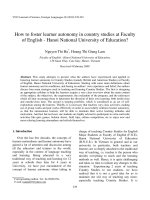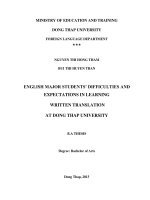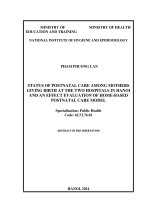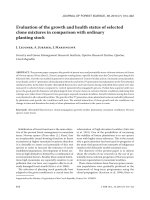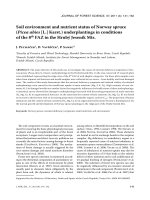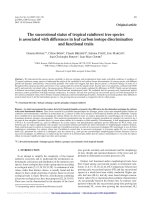Status of the collection of amphibians and reptiles in the Museum of Biology, Hanoi National University of Education
Bạn đang xem bản rút gọn của tài liệu. Xem và tải ngay bản đầy đủ của tài liệu tại đây (164.73 KB, 10 trang )
<span class='text_page_counter'>(1)</span><div class='page_container' data-page=1>
100
Status of the collection of amphibians and reptiles
in the Museum of Biology, Hanoi National University
of Education
Nguyen Lan Hung Son*, Le Trung Dung, Nguyen Thanh Van, Tran Nam Hai
<i>Hanoi National University of Education, 136 Xuan Thuy,Hanoi, Vietnam </i>
Received 10 January 2012
<b>Abstract. The collection of the Museum of Biology (HNUE) includes 102 species of amphibians </b>
and reptiles, accounted for 19.21% of the species was known in Vietnam, including 31 species of
amphibian and 71 reptile species. Amphibians and reptiles list statistic in this museum show that
23 species (22.55% of the total species) are rare and precious species. Among them, there are: 14
globally threatened species listed in IUCN's Red List, 2011. There are 12 nationally threatened
species listed in Red Data Book of Vietnam, 2007. 5 species listed in Decrees No 32/2006/ND-CP,
belonging to Group IIB (Limit on exploitation and use). There are 5 species listed in CITES
convention, 2009. 3 species haven’t been name yet. There are 386 specimens of amphibians and
reptiles on display at the museum. Samples of good quality up to 75%, the samples have average
quality and poor tiny percentage of 16% and 9%.
<i>Keywords:</i> amphibian, reptile, collection, museum, status, variety, quality.
<b>1. Introduction</b>∗∗∗∗
Building a standard collection for Museum
of Biology of Hanoi National University of
Education is essential to contributing in
development of natural museum systems in
Vietnam. It is also needed that the Museum of
Biology meets the requirement for research,
visit and education of natural environment and
biodiversity conservation in Vietnam. The
museum for learning of students and high
schooler, to visit of abroad institutions.
_______
∗<sub> Corresponding author. Tel: 84-4-37549530. </sub>
E-mail:
These surveys and studies of Department of
Zoology, the Faculty of Biology, Hanoi
National University of Education have collected
a large amount of specimens. Today, Museum
of Biology has the collection of diverse and
abundant amphibians and reptiles. They are
available in Vietnam.
</div>
<span class='text_page_counter'>(2)</span><div class='page_container' data-page=2>
<b>2. Study methodology </b>
<i>2.1. Study site and timing </i>
- Study sites: Amphibians and Reptiles
Collection in the Museum of Biology, the
Faculty of Biology, Hanoi National University
of Education.
- Study timing: During the October and
November in 2011.
<i>2.2. Study methodology </i>
To exactly assess the quality and diverse of
the collection of amphibians and reptiles at the
museum, we used the methods:
Systematic followed Bourret (1936, 1942)
[5], [6]; Dao (1978, 1979, 1981, 1982) [4];
Nguyen et al (2009) [7]. Common English
names generally follow Nguyen et al. (2009) [7].
To assess rare based on the Decree
32/2006/NĐ-CP of the Government (2006)[3];
CITES, 2009[2]; The Red Data Book of
Vietnam (2007) [1], The IUCN Red list of
Threatened Species 2011[8].
The status of amphibian, reptile specimens,
which is determined by three levels:
- Good: nearly complete specimens or
integrity, can recreate the full sample, is
properly treated and preserved.
- Medium: specimen form integrity or
nearly whole, a resume, but not sufficient
information, is handled well preserved (can
restore or improve)
- Bad: no profile form, or substantially
damaged invalid classification, poor handling
and storage has been corrupted. (will be
removed in the future)
<b>3. Results and discussions </b>
<i>3.1. Taxonomic diversity </i>
Today, in the collection of the Museum of
Biology (HNUE), there are 31 amphibian
species belonging to 7 families, 3 orders and 71
reptile species belonging to 16 families, 3
orders (table 1).
Table 1. List of amphibian and reptile composition at Museum of Biology (HNUE)
<b>The level of conservation </b>
<b>Order </b> <b>Scientific name </b> <b>Common name </b> <b>IUCN RB D. </b>
<b>32 </b>
<b>CITES </b>
<b>AMPHIBIA </b>
<b>I. ANURA </b>
<b>1. Bufonidae </b>
1 <i>Duttaphrynus melanostictus</i> (Schneider,
1799)
Back - spined toad
<b>2. Megophryidae </b>
2 <i>Brachytarsophrys feae </i>( Boulenger, 1887) Kakhien hill frog
3 <i>Xenophrys longipes (Boulenger, 1886) </i> Malacca spadefoot toad NT
4 <i>Xenophrys major </i>(Boulenger, 1908) Anderson’s spadefoot toad
<b>3. Microhylidae </b>
</div>
<span class='text_page_counter'>(3)</span><div class='page_container' data-page=3>
6 <i>Kaloula pulchra Gray, 1831 </i> Banded bullfrog
7 <i>Microhyla fissipes (Boulenger,1884) </i> Ornate pigmy frog
8 <i>Microhyla pulchra</i> (Hallowell, 1861) Guangdong rice frog
9 <i>Ophryophryne microstoma</i> Boulenger, 1903 Asian mountain toad
<b>4. Ranidae </b>
10 <i>Amolops ricketti</i> (Boulenger, 1899) Chinese sucker frog
11 <i>Fejervarya limnocharis</i> (Gravenhorst,
1829)
Grass frog
12 <i>Hoplobatrachus rugulosus</i> (Weigmann,
1835)
Common lowland frog
13 <i>Hylarana maosonensis Bourret, 1937 </i> Mauson frog
14 <i>Limnonectes kuhlii</i> (Tschudi, 1838) Kuhl’s creek frog
15 <i>Occidozyga lima</i> (Gravenhost, 1829) Green puddle frog
16 <i>Occidozyga martensii (Peters, 1867) </i> Marten’s oriental frog
17 <i>Odorrana andersonii (Boulenger, 1882) Anderson’s frog </i>
18 <i>Odorrana bacboensis </i>(Bain, Lathrop,
<i>Murphy, Orlov & Ho, 2003) </i>
Tonkin odorous frog
19 <i>Odorrana chloronota (Gunther, 1876) </i> Green cascade frog
20 <i>Odorrana graminea (Boulenger, 1900) </i> Graminea frog
21 <i>Paa verrucospinosa</i> (Buorret, 1937) Granular spiny frog NT
22 <i>Rana erythraea</i> (Schlegel, 1837) Green paddy frog
23 <i>Rana guentheri</i> (Boulenger, 1882) Gunther’s amoy frog
24 <i>Rana johnsi Smith, 1921 </i> Johns’ frog
25 <i>Rana nigrovittata</i> (Blyth, 1855) Black-striped frog
26 <i>Taylorana hascheanus</i> (Stoliczka, 1870) Hill forest frog
<b>5. Rhacophoridae </b>
27 <i>Polypedates dennysii</i> (Blanford, 1881) Deny’s whipping frog
28 <i>Polypedates leucomystax</i> (Gravenhorst,
1829)
Four- lined treefrog
<b>II. CAUDATA </b>
<b>6. Salamandridae </b>
29 <i>Paramesotriton deloustali</i> (Bourret, 1934) Vietnamese salamande VU IIB
30 <i>Tylototriton asperrimus </i>Unterstein, 1930 Granular newt NT
<b>III. GYMNOPHIONA </b>
<b>7. Ichthyophiidae </b>
</div>
<span class='text_page_counter'>(4)</span><div class='page_container' data-page=4>
<b>REPTILIA </b>
<b>IV. SQUAMATA </b>
<b>8. Agamidae </b>
32 <i>Acanthosaura lepidogaster</i> (Cuvier, 1829) Scale - bellied tree lizard
33 <i>Calotes versicolor</i> (Daudin, 1802) Garden fence lizard
34 <i>Calotes sp. </i>
35 <i>Draco maculatus (Gray, 1845) </i> Spotted gliding lizard
36 <i>Leiolepis reevesii</i> (Gray, 1831) Eastern butterfly lizard
37 <i>Pseudocalotes floweri</i> (Boulenger, 1912) Thai false broodsucker
<b>9. Gekkonidae </b>
38 <i>Gehyra mutilata</i> (Wiegmann, 1834) Four- clawed gecko
39 <i>Gekko gecko</i> (Linnaeus, 1758) Tockay VU
40 <i>Gekko palmatus Boulenger, 1907 </i> Palmated gecko
41 <i>Hemidactylus frenatus</i> Schelegel, in
Dumeril et Bibron, 1836
Spiny- tailed house gecko
<b>10. Lacertidae </b>
42 <i>Takydromus sexlineatus</i> Daudin, 1802 Long-tailed grass lizard
<b>11. Scincidae </b>
43 <i>Eumeces tamdaoensis Bourret, 1937 </i> Tamdao blue-tailed skink
44 <i>Mabuya chapaensis (Bourret, 1937) </i> Sapa mabuya
45 <i>Mabuya longicaudata</i> (Bourret, 1937) Long- tailed skink
46 <i>Scincella reevesii (Gray, 1838) </i> Reeves' Smooth Skink
47 <i>Sphenomorphus indicus ( Gray, 1853) </i> Indian forest skink
48 <i>Sphenomorphis maculatus (Blyth, 1853) Spotted forest shink </i>
<b>12. Shinisauridae </b>
49 <i>Shinisaurus crocodilurus </i>Ahl, 1930 Chinese crocodile lizard VU II
<b>13. Varanidae </b>
50 <i>Varanus nebulosus (Gray, 1831) </i> Clouded monitor EN
51 <i>Varanus salvator</i> (Laurenti, 1786) Water monitor EN
<b>14. Typhlopidae </b>
52 <i>Ramphotyphlops braminus</i> (Daudin, 1803) Common blind snake
<b>15. Xenopeltidae </b>
53 <i>Xenopeltis unicolor</i> Reiwardt, in Boie, 1827 Sunbeam snake
<b>16. Colubridae </b>
</div>
<span class='text_page_counter'>(5)</span><div class='page_container' data-page=5>
57 <i>Amphiesma stolatum (Linnaeus, 1758) </i> Buff-striped keelback
58 <i>Boiga multomaculata (Boie,1827) </i> Large-spotted cat snake
59 <i>Calamaria pavimentata </i>Dume’ril &
<i>Bibron 1854 </i>
Collared reed snake
60 <i>Calamaria septentrionalis</i> Boulenger, 1890 Northern reed snake
61 <i>Cyclophiops multicinctus</i> (Roux, 1907) Munticincted green snake
62 <i>Dinodon meridionale Bourret, 1935 </i> Southern big-tooth snake
63 <i>Enhydris bennettii (Gray, 1842) </i> Mangrove water snake
64 <i>Enhydris chinensis (Gray, 1842) </i> Chinese water snake
65 <i>Enhydris plumbea</i> (Boie, 1827) Plumbeous water snake
66 <i>Oligodon cinereus (Gunther, 1864) </i> Ashy kukri snake
67 <i>Opisthotropis lateralis Boulenger, 1903 Bicoloured keelback </i>
68 <i>Pareas hamptoni (Boulenger, 1905) </i> Hampton’s slug snake
69 <i>Psammodynastes pulverulentus (Boie, 1827) Mock viper </i>
70 <i>Pseudoxenodon macrops (Blyth, 1854) </i> Big-eyed bamboo snake
71 <i>Pseudoxenodon bambusicola Vogt, 1922 </i> Bamboo snake
72 <i>Ptyas korros</i> (Schlegel, 1837) Indochinese ratsnake EN
73 <i>Rhabdophis subminiatus (Schlegel, 1837) Red-necked keelback </i>
74 <i>Sinonatrix percarinata</i> (Boulenger, 1899) Mountain water snake
75 <i>Xenochrophis flavipunctatus</i>
(Hallowell, 1861)
Yellow-spotted keelback
76 <i>Xenochrophis trianguligerus </i>(Boie, 1827) Triangle water snake
<b>17. Elapidae </b>
77 <i>Bungarus bungaroides (Cantor, 1839) </i> Common krait
78 <i>Bungarus candidus (Linnaeus, 1758) </i> Blue krait IIB
79 <i>Bungarus fasciatus</i> (Schneider, 1801) Banded krait EN
80 <i>Bungarus multicinctus</i> Blyth, 1861 Many - banded krait IIB
81 <i>Calliophis maculiceps (Gunther, 1858) </i> Small-spotted coral snake
82 <i>Hydrophis sp1. </i>
83 <i>Hydrophis sp2. </i>
84 <i>Naja atra</i> Cantor, 1842 Chinese cobra EN IIB II
<b>18. Viperidae </b>
85 <i>Cryptelytrops albolabris</i> (Gray, 1842) White - lipped pitviper
86 <i>Ovophis tokinensis (Bourret, 1934) </i> Tonkin pitviper
87 <i>Protobothrops mucrosquamatus </i>
<i>(Cantor, 1839) </i>
</div>
<span class='text_page_counter'>(6)</span><div class='page_container' data-page=6>
<b>V. TESTUDINATA </b>
<b>19. Geoemydidae </b>
90 <i>Cuora galbinifrons Bourret, 1939 </i> Indochinese box turtle CR EN II
91 <i>Cyclemys tcheponensis (Bourret, 1939) </i> Stripe – necked leaf turtle
92 <i>Geoemyda spengleri</i> (Gmelin,1789) Black-breasted leaf turtle EN III
93 <i>Pyxidea mouhoti</i> (Gray, 1862) Keeled box turtle II
94 <i>Sacalia quadriocellata (Siebenrock, 1903) Four-eyed turtle </i> EN
95 <i>Trachemys scipta (Wied-Neuwied, 1839) Red-eared slider </i>
<b>20. Testudinidae </b>
96 <i>Indotestudo elongata (Byth, 1853) </i> Elongated tortoise EN IIB
97 <i>Manouria impressa</i> (Gunther, 1882) Impressed tortoise VU VU
<b>21. Trionychidae </b>
98 <i>Amyda cartilaginea (Boddaert, 1770) </i> Asiatic Softshell Turtle VU VU
99 <i>Palea steindachneri</i> (Siebenrock, 1906) Wattle-necked softshell turtle
100 <i>Rafetus swinhoei </i>(Gray, 1873) (*) Swinhoe’s softshell turtle CR CR
<b>22. Cheloniidae </b>
101 <i>Eretmochelys imbricata </i>(Linnaeus, 1766) Hawksbill sea turtle CR EN
<b>VI. CROCODYLIA </b>
<b>23. Crocodylidae </b>
102 <i>Crocodylus siamensis Schneider, 1801 </i> Siamese crocodile CR CR
<i>Notes: </i>
<i>IUCN (The IUCN Red list of Threatened Species, 2011), RB (Red Data Book of Vietnam, 2007): CR: Critically </i>
endangered; EN: Endangered; VU: Vulnerable; NT: Near threatened.
<i>D. 32 (Decree 32/2006/NĐ-CP of the Vietnam Goverment) : Group IIB (Limit on exploitation and use). </i>
<i>CITES (Convention on International Trade in Endangered Species of Wild Fauna and Flora, 2009): II = Appendices II, </i>
III = Appendices III.
(*): Skull speciment.
Table 1 and Table 2 show that:
- Amphibia: There are 3 orders (50.00% of
the statistics), seven families (accounting for
30.44%), 21 genus (27.15%) and 31 species
(30.39%) , which dominate is the Ranidae
family with 10 genus and 17 species. Next to,
Microhylidae family has got 4 genus and 5
species. Megophryidae family with 2 genus and
3 species. The Salamandridae family has 2
genus and two species. The Rhacophoridae
family includes 1 genus, Bufonidae and
Ichthyophiidae have 1 genus, 1 species.
Table 2. Diversity of the taxon levels of amphibian and reptile specimens at the Museum of Biology
<b>Family </b> <b>Genus </b> <b>Species </b>
<b>TT </b> <b>Class </b> <b>Order </b>
No. % No. % No. %
<b>Anura </b> 5 21.74 18 24.00 28 27.45
<b>Caudata </b> 1 4.35 2 2.67 2 1.96
1 Amphibia
<b>Gymnophiona </b> 1 4.35 1 1.33 1 0.98
<b>Squamata </b> 11 47.81 41 54.67 58 56.86
<b>Testudinata </b> 4 17.40 12 16.00 12 11.77
2 Reptilia
</div>
<span class='text_page_counter'>(7)</span><div class='page_container' data-page=7>
- Reptilia: There are three orders
(representing 50.00%), 16 families (accounting
for 69.56%), 54 genus (accounting for 71.05%)
and 71 species (69.61%). In particular, the
Squamata order is the most diversesity order
about the taxa with 11 families (accounting for
47.83%), 41 genus (accounting for 54.67%), 58
species (56.86%). The Colubridae family
dominates with 16 genus and 23 species. The
Geoemydidae family has 6 genus and 6 species.
Along with a genus and a species, they are
Lacertidae, Shinisauridae, Typhlopidae,
Xenopeltidae, Cheloniidae and Crocodylidae
family.
Thus, the Squamata order is the most
diversesity in all orders (11 families, 41 genus,
58 species), Colubridae which is the dominate
family. Next, the Anura order with 5 families,
18 genus and 28 species, with their dominant
Ranidae. Lower than that of the Gymnophiona
order and the Crocodylia order, only one
family, a genus, a species.
Assessing to the rich of the gallery
collection at the Museum of Biology, we
compared with the figures in the checklist of
amphibians and reptiles Vietnam in 2009 [7]
and obtained fig 1. and fig 2.
Amphibia class of Vietnam are represented
in three orders at the Museum of Biology. The
exhibition, there are 70% of amphibia families
in Vietnam. Three amphibians family do not
have represented as Bombinatoridae, Hylidae,
Dicroglossidae. The Amphibia genus just
43.18% and accounted for 16.18% of
represented genus have been known in
Vietnam.
Reptile class of Vietnam has the
representatives of the three orders at the
Museum. The specimen represents 66.67% of
families, 38.93% of the genus, 17.32% of
reptile species in Vietnam.
3
10
44
173
3
7
21
31
Order
Family
Genus
Species
<b>No.</b>
Vietnam Museum of biology
3
24
131
358
3
16
54
71
0 50 100 150 200 250 300 350 400
Order
Family
Genus
Species
<b>No.</b>
Vietnam Museum of biology
Fig 1. Compare amphibian taxa. Fig 2. Compare reptile taxa.
Comparing the collection of amphibian and
reptile species of the Museum of Biology with
corresponding specimens at the Biological
</div>
<span class='text_page_counter'>(8)</span><div class='page_container' data-page=8>
Table 3. Comparison of the amphibian and reptile taxa at the two museums
<b>Order </b> <b>Family </b> <b>Genus </b> <b>Species </b>
<b>TT </b> <b>Class </b>
HNUE HUS HNUE HUS HNUE HUS HNUE HUS
1 Amphibia 3 3 7 8 21 13 31 20
2 Reptilia 3 3 16 21 54 79 71 122
<b>Total </b> <b>6 </b> <b>6 </b> <b>23 </b> <b>29 </b> <b>75 </b> <b>92 </b> <b>102 </b> <b>142 </b>
<i>Notes: </i>
HNUE: Museum of Biology, Hanoi National University of Education.
HUS: Biological Museum, Hanoi University of Science, Vietnam National University, Hanoi
Through this comparison, we found that the
collection of amphibians and reptiles in the
museums are fully representative of Vietnam.
The amphibian specimens in the Museum of
Biology (HNUE) is richer than its in the
Biological Museum (HUS), but the reptile
specimens at the Biological Museum (HUS)
diversity than.
<i>3.2. Rare and endemic </i>
Amphibians and reptiles list statistic in this
museum show that 23 species (22.55% of the
total species) are rare and precious species. In
which, four of amphibian species (3.92%), 19
species of reptile (18.63%). Specifically:
5 species listed in Decrees No
32/2006/ND-CP belonging to Group IIB (Limit on
exploitation and use). In which, including a
<i>representative of amphibia Paramesotriton </i>
<i>deloustali and 4 species of reptilia: Bungarus </i>
<i>candidus, Bungarus multicinctus, Naja atra and </i>
<i>Indotestudo elongate. </i>
There are 12 nationally threatened species
listed in Red Data Book of Vietnam, 2007; with
2 species in the CR category, 7 species in the
category of EN and three species in the VU
category. Of which, only one species in the
Crocodylia order, 6 species of the Squamata
order and five species of the Testudinata order.
The reptile specimens in the Museum of
Biology accounted for 13.75% of the reptiles in
the Red Data Book of Vietnam in 2007.
Amphibian class has no representative.
There are 14 globally threatened species
listed in IUCN's Red List, 2011. Mainly
concentrated in the Testudinata order with 8
species; two species of Anura order; the
Caudata, Squamata and Crocodylia order have a
representative of each. In the species, there are
three species in the NT category of Anura
order, 4 species in the section of VU, three
species in the EN secsion and four species in
the CR category.
There are 5 species listed in CITES
convention, 2009. In which, 1 species in the
<i>Appendices III (Geoemyda spengleri) and 4 </i>
species in Appendices II <i>(Naja </i> <i>atra, </i>
<i>Shinisaurus crocodilurus, Coura galbinifrons</i>
<i>and Pyxidea mouhoti). In the species, the </i>
Testudinata order has 3 species and 2 species in
the Squamata order.
<i>3.3. Quality of the amphibian and reptile </i>
<i>collection </i>
<i>- Specimen types: </i>
</div>
<span class='text_page_counter'>(9)</span><div class='page_container' data-page=9>
with frogs and placed prone on glass in glass
jars or plastic bottles.
Some specimens, they are body parts with a
number of species in the Testudinata order as
skulls, turtle shell patterns.
With the large reptile specimens like
<i>Varanus salvator, or Crocodylus siamensis, the </i>
museum handled and displayed stuffed forms.
<i>- Collect timing: </i>
Most specimens were collected since a long
years ago. The specimens were collected in
different areas of the country, from north to
south, on the field research phase of the staff in
Faculty of Biology, graduate students, master
and Ph.D students.
In the recently years, along with the
development of the preservation in Museum of
Biology, the number of amphibian, reptile
specimens were collected, processed and
displayed in this increasingly richer for day by
day.
<i>- Quality of the collection: </i>
In the 386 specimens of amphibians and
reptiles is showing at the museum, there are 289
species accounted for 75% good specimens, 62
specimens in average quality (16%) and 35
specimens has bad quality, for 9% less.
75%
16%
9%
Good speciment
Medium speciment
Bad speciment
Fig 3. Rate of the specimen qualities.
<b>4. Conclusion </b>
The collection of amphibian, reptile
specimens stored in the Museum of Biology
(HNUE) are diversity in quantity and species
currently. It includes 102 species of amphibians
and reptiles, accounted for 19.21% of the
species was known in Vietnam, including 31
species of amphibians and 71 reptile species.
</div>
<span class='text_page_counter'>(10)</span><div class='page_container' data-page=10>
There are 386 specimens of amphibians and
reptiles on display at the museum. Samples of
good quality up to 75%, the samples have
average quality and poor tiny percentage of
16% and 9%.
In the future, need to complete collection of
specimens (the specimen is mistake in the
collection or the specimens will be discarded
because of due to unsatisfactory). To use of
advanced techniques in handling, processing
and preserving specimens.
<b>Acknowledgements </b>
This study has been conducted with
supports by the focal ministerial level research
programmer, coded B2010-17-272TĐ
<b>References </b>
[1] Ministry of Science and Technology, Vietnam
Academy of Science and Technology, 2007.
<i>Vietnam Red Book</i>, Part I: Animals. Publishing
House Science and Technology, Hanoi.
[2] Convention on International Trade in
Endangered Species of Wild Fauna and Flora,
<i>2009. The list of wild fauna and flora species </i>
<i>specified </i> <i>in </i> <i>CITES </i> <i>Appendices</i>, the
International Trade of Animals and Plants
endangered.
[3] Government of the Socialist Republic of
<i>Vietnam, 2006. Decree No. 32/2006/ND-CP of </i>
<i>the Government 30 March 2006 </i> on the
management of endangered, endangered
animals, endangered.
[4] <i>Dao V.T. The identification of amphibians, </i>
<i>reptiles of Vietnam</i>. Journal of Biological-Land
Study, Hanoi, 1977 (33-40), 1978 (1-6), 1979
(2-10), 1981 (1-6), 1982 (5-9).
[5] <i>Bourret R., 1936. Les serpents de l’Indochine. </i>
H.Dasuyau, Toulouse, vols.1 et 2.
[6] Bourret R., 1942. <i>Les </i> <i>Batraciens </i> <i>de </i>
<i>l’Indochine</i>. Institut Oce’anographique de
l’Indoch, Ha Noi.
[7] Nguyen Van Sang, Ho Thu Cuc, Nguyen Quang
<i>Truong, 2009. Herpetofauna of Vietnam. </i>
Edition Chimaira, Frankfurt amMain.
[8] <i>IUCN, 2011. The IUCN Red list of Threatened </i>
<i>Species</i>. Source: .
Hiện trạng bộ mẫu lưỡng cư và bò sát
tại Bảo tàng Sinh vật, Trường Đại học Sư phạm Hà Nội
Nguyễn Lân Hùng Sơn, Lê Trung Dũng, Nguyễn Thanh Vân, Trần Nam Hải
<i>Trường Đại học Sư phạm Hà Nội, 136 Xuân Thủy, Hà Nội, Việt Nam </i>
</div>
<!--links-->

